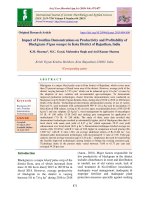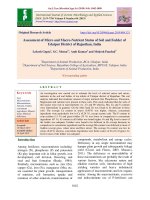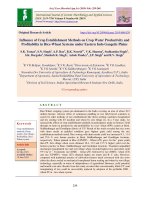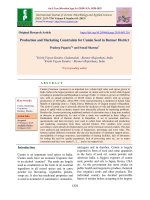Impact of frontline demonstrations on productivity and profitability of Blackgram (Vigna mungo) in Kota District of Rajasthan, India
Bạn đang xem bản rút gọn của tài liệu. Xem và tải ngay bản đầy đủ của tài liệu tại đây (275.95 KB, 7 trang )
Int.J.Curr.Microbiol.App.Sci (2019) 8(4): 871-877
International Journal of Current Microbiology and Applied Sciences
ISSN: 2319-7706 Volume 8 Number 04 (2019)
Journal homepage:
Original Research Article
/>
Impact of Frontline Demonstrations on Productivity and Profitability of
Blackgram (Vigna mungo) in Kota District of Rajasthan, India
K.M. Sharma*, M.C. Goyal, Mahendra Singh and Anil Kumar Sharma
Krishi Vigyan Kendra, Borkhera, Kota (Rajasthan)-324001, India
*Corresponding author
ABSTRACT
Keywords
Blackgram, B:C
ratio, Frontline
demonstration,
Technological gap
Article Info
Accepted:
07 March 2019
Available Online:
10 April 2019
Blackgram is a major kharif pulse crop in Kota district of Rajasthan, which covers more
than 25 percent acreage of kharif sown area of the district. However, average yield of the
district varying between 5-7.25 q ha-1 which can be enhanced up to 10 q ha-1 or more by
the adoption of new varieties and recommended agro-techniques. To demonstrate
improved production technologies, cluster front-line demonstrations were conducted on
blackgram crop by Krishi Vigyan Kendra, Kota, during kharif 2016 to 2018 on 260 farmer
fields of the district. Technological interventions demonstrated consists of use of variety
Pant urd-31, seed treatment with carbendazim50 WP @ 2.0 g /kg seed & inoculation of
Rhizobium & PSB culture, sowing in 30 cm rows apart, recommended doses of NP (20-40
kg ha-1) and zinc sulphate (25 kg ha-1), weed management by application of imazathapyr
10 SL @ 550 ml/ha 15-20 DAS and sucking pest management by application of
imidacloprid 17.8 SL @ 250 ml/ha. The study of three years data revealed that
demonstrated technologies resulted in substantially higher yield of blackgram than that of
local check with mean seed yield of 8.37 q ha -1 which represents 39.27 cent yield
enhancement over local check (6.01 q ha-1). Demonstrated techniques fetched average net
returns of Rs 21345 ha-1 with B: C ratio of 2.09, higher in comparison to local practice (Rs
13627 ha-1 with B: C ratio 1.86). An average additional returns of Rs.11484 ha -1 was
obtained under demonstrated technologies with incremental B: C ratio of 3.05. Yield gap
analysis showed average extension gap of 2.36 q ha -1, emphasizes the need for transferring
the feasible improved technologies among farmers to bridge the existing extension gap.
Technology index in the present study varied between 31.00 to 61.73 per cent and
averaged 44.20 per cent.
(Anon., 2018). Major factors responsible for
low productivity of blackgram in the district
includes disturbances in onset and distribution
in rainfall, use of old variety seeds, lack of
seed treatment & bio-fertilizer inoculation,
inadequate weed management, inadequate &
improper fertilizer and inadequate plant
protection measures specially against sucking
Introduction
Blackgram is a major kharif pulse crop of the
district Kota, area of which increased from
mere 21126 ha in kharif 2015 to 98729 ha in
kharif 2018. However, average productivity
of blackgram in the district is varying
between 5.0 to 7.6 q ha-1 during 2016 to 2018
871
Int.J.Curr.Microbiol.App.Sci (2019) 8(4): 871-877
pest. There exist ample scope to enhance the
average productivity of blackgram up to 10 q
ha-1 or more by the adoption of improved
varieties with yellow vein mosaic resistance
and recommended agro-techniques. Farmers
in the Kota district are using seeds of old
varieties i.e. T-9, Krishna and local seeds.
These varieties suffer due to yellow vein
mosaic disease and produce less number of
pods per plant. Yellow vein mosaic
transmitted through white flies has been a
serious production constraint in blackgram
cultivation in India (Singh et al., 2015). Pant
urd-31, a yellow vein mosaic resistance
variety developed at G.B. Pant university of
agriculture & technology, Pantnagar and has
been recommended for cultivation in
Rajasthan and other states of India.
Baluhera, Nangalheri, Sohankhera, Haripura
and Bagtari. Kota District falls under Agroclimatic Zone-V “Humid South-eastern plain
zone” of Rajasthan. The climate in the district
is semi arid and moderate. Soils of the study
area clay loam in texture with low nitrogen,
low to medium phosphorus, high in available
potassium and widely deficient in zinc. The
area under each FLD’s was kept 0.4 to 0.5 ha
with farmers practice as control plots.
Farmer’s for the FLD’s were selected based
on group meeting taking in to consideration
mainly the approachable site and adaptive
attitude of the farmers. Technological
interventions under demonstration were
decided based on technological gap analysis
(Table 1). Based on gap analysis,
technological interventions demonstrated
includes improved variety Pant Urd-31, seed
treatment with Carbendazim 50 wp @ 2 g/kg
seed & inoculation with Rhizobium & PSB
cultures, soil treatment with Trichoderma
viride @ 2.5 kg/ha (mixed with 20-25 kg
FYM), sowing at 30 cm. rows spacing,
recommended NP (20:40 kg/ha) and zinc
@25 kg/ha, weed management by application
of Imizathapyr 10 SL @ 550 ml /ha at 15-20
DAS and sucking pest management by spray
of Imidacloprid 17.8 SL 250 ml/ha. Selected
farmers were provided trainings on advanced
agro-techniques for higher productivity of
blackgram. Critical inputs decided based on
technological gap analysis were provided and
other inputs were suggested as per need. Crop
was sown during last week of June to second
week of July drilled in 30 cm rows apart.
Research
for
improving
agricultural
productivity does not serve its purpose till it
reaches to the farmer’s fields. Frontline
demonstrations are one of the important
dissemination process for transfer of
technology and to establish its production
potentials on the farmer’s field. Therefore,
frontline demonstrations were conducted
during kharif seasons of the year 2016 to
2018 on selected farmer’s fields of the
operational area of Krishi Vigyan Kendra,
Kota with the objective of exhibiting the
performance of improved variety Pant Urd-31
along with cost-effective improved agrotechniques which could be adopted by the
farmers for yield enhancement.
Materials and Methods
All steps like site and farmer selection, layout
of demonstration, farmer’s participation etc.
were followed as suggested by Choudhary
(1999). Monitoring of CFLD sites were done
by periodical visits and needful suggestion
were given to the farmers. Field days were
also organized at crop maturity to
demonstrate the impact of CFLD among other
farmers of the area for horizontal spread of
Cluster Frontline demonstrations (CFLD’s)
were conducted under National Food security
Mission during kharif seasons of year 2016 to
2018 in 110 ha area on 260 farmers fields
covering 13 different villages of operational
area of KVK, Kota namely Suhana,
Abhaypura, Tahla, Umarhedi, Padasliya,
Dungarjya,
Bhandahera,
Godliyaheri,
872
Int.J.Curr.Microbiol.App.Sci (2019) 8(4): 871-877
technologies. The crop was harvested during
second fortnight of September. Data related to
yield and cost particulars were collected
separately for CFLD and farmers practice.
The average prices of inputs and outputs
commodities prevailed during each year of
demonstrations were taken for calculating
cost of cultivation, net return and benefit cost
ratio. The technology gap, extension gap and
technology index were calculated as
suggested by Samui et al., (2000).
Technology gap =
Demonstration yield
Potential
yield
Pant Urd-31 and recommended package of
practices applied. The variety showed better
branching, comparatively more number of
pods per plant. This variety was not infected
with yellow vein mosaic virus disease. More
number of pods observed under CFLD plots
also ascribed due to effective sucking pest
management through spray of Dimethoate 30
EC 1.0 litre /ha or Imidacloprid 17.8 SL 250
ml/ha. Similarly, yield enhancement in
blackgram crop though cluster front line
demonstrations were documented by Bairwa
et al., (2013), Dwivedi et al., (2018) and
Saikia et al., (2018).
-
Extension gap = Demonstration yield Farmers yield
A perusal of data (Table 2) further reveals
that values for extension gap ranged from
1.58 to 3.10 q ha-1 with a mean value of 2.36 q
ha-1 during the period of demonstration which
emphasizes the need for transferring the
feasible improved technologies among
farmers to bridge the extension yield gap.
Technology gap which implies researchable
issues for realization of potential yield ranged
from 4.65 to 9.26 q ha-1, with a mean of 6.63
q ha-1 during three years of demonstration.
Yearly variation in the technology gap might
be due to dissimilarity in soil fertility status,
rainfall distribution as well as change in
location of demonstration sites. Higher
technological gap observed during kharif
2018 might be due to yield losses caused by
heavy rainfall at maturity phase of the crop.
Technology index (%) = (Technology gap/
Potential yield) × 100
Results and Discussion
The data on average yield (Table 2) reveals
that application of demonstrated technologies
resulted in substantially higher blackgram
yield than that of local check (farmer’s
practice) during all the three years (2016 to
2018). The average yield of blackgram during
three years ranged from 5.74 to 10.35 q ha-1
under demonstrated technologies as against
4.16 to 7.25 q ha-1 under farmers practices
(local check). Higher yield observed during
kharif 2017 might be due to favorable rainfall
conditions. Yield performance during kharif
2018 was recorded lower due to heavy rainfall
at flowering as well as maturity phase which
caused loses by water logging conditions.
Three years pooled data show that
demonstrated technologies recorded mean
yield of 8.37 q ha-1 which represents 39.27 per
cent yield enhancement over local check (6.01
q ha-1). The higher productivity of blackgram
under demonstration in comparison to
farmer’s local practice could be ascribed
mainly to the use of YMV resistant variety
Technology index shows the feasibility of
evolved technology at the farmer’s field and
lower the value of technology index more is
the feasibility of the technology (Katare et al.,
2011).
Technology index in the present study varied
between 31.0 to 61.73 per cent and averaged
44.20 per cent. Variation in technology index
during three seasons might be attributed to
dissimilarity in the rainfall pattern and soil
condition (Fig. 1).
873
Int.J.Curr.Microbiol.App.Sci (2019) 8(4): 871-877
Economic indicators i.e. gross cost of
cultivation, gross returns, net returns and B:C
ratio of front line demonstrations are
presented in Table 3. The gross cost of
cultivation for blackgram cultivation under
demonstrated practice ranged from Rs. 17849
to 20675 ha-1 with a mean value of Rs. 19553
ha-1 against local check where it ranged from
Rs.13650 to 17380 ha-1 with an average of Rs.
15787 ha-1. The data clearly shows that
demonstrated
technologies
provided
substantially higher net returns than local
check i.e. farmers practice during all the years
of demonstration. FLD practice on three years
average, fetched net returns of Rs 21345 ha-1
with B: C ratio of 2.09, higher in comparison
to local practice (Rs 13627 ha-1, B:C ratio
1.86). An average additional returns of
Rs.11484
ha-1
was
obtained under
demonstrated technologies with incremental
B: C ratio of 3.05 which might be attributed
to yield enhancement under demonstration
with least additional cost. Higher cost benefit
ratio and additional returns clearly shows that
demonstrated techniques were found cost
effective & feasible for yield enhancement of
blackgram on farmer’s fields. Farmer’s were
also found highly convinced with the
technological interventions due to higher
economic returns with least additional
investment and management practices. The
variation in cost benefit ratio during different
years might be due to variation in yield
performance and input output cost in that
particular year.
Reasons of low yield of blackgram at
farmer's fields
Use of old varieties seeds with yellow vein
mosaic incidence, use of very high seed rate
resulting in improper plant geometry, no
practice of seed treatment and inadequate use
of fertilizers, inadequate weed management
and inadequate protection against sucking
pests and diseases are major reasons for low
yields of blackgram on farmers fields in the
district.
Table.1 Technological gap analysis for CFLD on Blackgram
Technological point
Existing Farmer’s practice
Variety
Seed rate
Seed treatment
Variety T-9, Local
20-25 kg/ha
30% farmers treat the seeds with
fungicide like carbendazim
Soil treatment
Crop geometry
Fertilizer application
Weed management
Insect-pest
management
Recommended practice
Variety PU-31
15-20 kg/ha
Seed treatment with carbendazim 50WP @
2.0 g /kg seed and inoculation with
Rhizobium and PSB cultures
No soil treatment
Soil treatment by Trichoderma viridie @
2.5 kg/ha (mixed with 20-25 kg FYM)
Sowing crops in 22.5 cm rows
Sowing crops in 30 cm rows
Majority of farmers did not apply any Fertilizer based on STR or Recommended
fertilizer
doses of NP (20:40 kg/ha) as basal, zinc
sulphate @ 20-25 kg and sulphur 40 kg/ha
No or injudicious use of herbicides
Application of Imizathapyr 10SL @ 55 ml
available in market
ai/ha at 15-20 DAS and hand weeding as
per need
No use of insecticides for sucking
Spray of Dimethoate 30 EC 1.0 litre /ha or
pests or indiscriminate use of
Imidacloprid 17.8 SL 300 ml/ha for
insecticides
sucking pest
874
Int.J.Curr.Microbiol.App.Sci (2019) 8(4): 871-877
Table.2 Impact of Front Line Demonstrations (FLD) on yield performance of blacklgam
Season & Year
No.
of
FLD
60
Kharif 2016
75
Kharif 2017
125
Kharif 2018
Mean
Area
of FLD
(ha)
30.0
30.0
50.0
Yield (q/ha)
IT
FP
9.02
10.35
5.74
8.37
6.62
7.25
4.16
6.01
%
increase
over FP
36.25
41.33
38.15
39.27
Extension
Gap
(q/ha)
2.40
3.10
1.58
2.36
Technology
Gap
(q/ha)
5.98
4.65
9.26
6.63
Technology
Index
(%)
39.87
31.00
61.73
44.20
FP- Farmer’s local practice
IT- Improved technology
Table.3 Impact of Front Line Demonstration on economic indicators of blackgram
Season &
Year
Kharif
2016
Kharif
2017
Kharif
2018
Mean
Gross cost of
cultivation
(Rs./ha)
IT
FP
20135 17380
Gross Return
(Rs./ha)
Net Returns
(Rs./ha)
B:C
ratio
Additional Incremental
Returns
B:C ratio
(Rs./ha)
IT
FP
56375 41375
IT
FP
36240 23995
IT
2.80
FP
2.38
15000
5.44
20675
16330
41400
29000
20725
12670
2.00
1.78
12400
2.85
17849
13650
24919
17867
7070
4217
1.40
1.31
7052
1.68
19553
15787
40898
29414
21345
13627
2.09
1.86
11484
3.05
Fig.1 Changing scenario of blackgram cultivation in Kota district during 2014-2018
875
Int.J.Curr.Microbiol.App.Sci (2019) 8(4): 871-877
bio-fertilizer inoculants, use of recommended
fertilizers, weed management practices and
integrated
insect–pest
management
techniques. It is concluded that the CFLD
programme is a successful tool in enhancing
the production and productivity of blackgram
crop through changing the knowledge,
attitude and skill of farmers. Blackgram yield
as well as economic returns at farmers fields
enhanced through adoption of Pant urd-31
variety along with improved recommended
practices.
Impact of front line demonstrations
Earlier years, incidence of YMV was the
major constraint for urdbean cultivation,
therefore, the area under blackgram
cultivation remained less than 25 thousand ha
in the district. Soybean has been a major
kharif crop of the district which was
cultivated in 194.3 thousand ha area during
kharif 2015, however, productivity of soybean
remained below 12.5 q ha-1 due to
unfavorable rainfall during the study period.
Introduction of short duration, high yielding
and YMV resistant variety Pant Urd-31 of urd
bean through front line demonstrations and
with the support of line department of
agriculture, the area of blackgram has
increased from 7.78 thousand ha in kharif
2013 to 1.028 lakh ha in kharif 2017 (Anon.,
2017). The performance of PU-31 variety was
found quite satisfactory as it showed YMV
resistance, pod matured at one time and yield
was found on an average 25-40 per cent
higher over local check T-9. This variety of
blackgram became so popular that remarkable
area of soybean has been replaced by
blackgram
cultivation.
Quality
seed
production of 360 q of variety Pant Urd-31
was also taken at KVK farm and farmers’
field under pulse seed hub, which add in the
rapid horizontal expansion of the variety.
Acknowledgement
The authors are thankful to the Director
Extension, Agriculture University, Kota and
Director, ATARI, Zone II, Jodhpur (ICAR)
for providing financial assistance towards
conducting these front line demonstrations.
References
Anonymous (2017). Rajasthan Agricultural
Statistics At a glance, Govt. of
Rajasthan. 2016-17 PP -79
Anonymous (2018). Land records, Revenue
department, Govt. of Rajasthan.
Bairwa, R. K., S. R. Verma, K. Chayal and N.
L. Meena. (2013). Popularization of
Improved Black gram Production
Technology through Front line
demonstration in humid southern plain
of Rajasthan, Indian Journal of
Extension Education and R.D. 21: 97101.
Choudhary, B. N. 1999. Krishi Vigyan
Kendra - A guide for KVK managers.
Publication, Division of Agricultural
Extension, ICAR. pp 73-78.
Dwivedi, R. K. , B. K. Tiwari and K. S.
Baghel. (2018). Role of cluster front
line demonstrations in enhancement of
blackgram (Vigna mungo) production.
Plant Archives 18 (1) : 1088-1090.
Katare, S., S.K. Pandey, and M. Mustafa,
In conclusion, the results of cluster front line
demonstrations presented clearly indicates
that the blackgram productivity can be
enhanced to the magnitude of 36.2 to 41.3 per
cent on farmers fields with the popularization
of improved production technologies on
farmers fields in Kota district. There is the
need of transfer of adoptable technologies
suitable for enhancing the productivity of
blackgram crop through conducting such
demonstrations. Technological and extension
gaps can be bridged by popularizing package
of practices with emphasis on improved
variety seed, seed treatment, integration of
876
Int.J.Curr.Microbiol.App.Sci (2019) 8(4): 871-877
.2011. Yield gap analysis of
Rapeseed-mustard through front line
demonstrations. Agric. Update, 6(2):
5-7.
Saikia, Nabadeep, Kapil Nath and Pulakabha
Chowdhury (2018). Impact of cluster
frontline
demonstrations
on
popularization of blackgram var. PU
31 in Cachar district of Barak Valley
region of Assam. Journal of
Pharmacognosy and Phytochemistry
2018; 7(4): 940-942.
Samui, S K, S. Maitra, D. K. Roy, A. K.
Mondal and D. Sahu .2000.
Evaluation of front line demonstration
on groundnut. Journal of Indian
Society of Costal Agricultural
Research 18(2): 180-306.
Singh, D.P., B.B. Singh and Sanjeev
Gupta.2015. Development of Pant Urd
31: A high yielding and yellow mosaic
disease resistant variety of blackgram.
Journal of Food Legumes 28(1): 1-4.
How to cite this article:
Sharma, K.M., M.C. Goyal Mahendra Singh, and Anil Kumar Sharma. 2019. Impact of
Frontline Demonstrations on Productivity and Profitability of Blackgram (Vigna mungo) in
Kota District of Rajasthan, India. Int.J.Curr.Microbiol.App.Sci. 8(04): 871-877.
doi: />
877







![Generation mean analysis for yield, yield components and MYMV disease scores in blackgram [Vigna mungo (L).Hepper]](https://media.store123doc.com/images/document/2020_01/09/medium_kiu1578565010.jpg)

